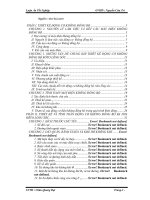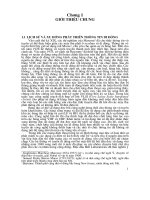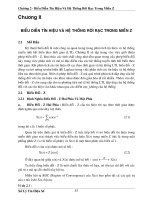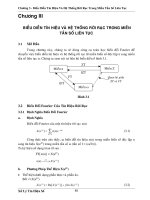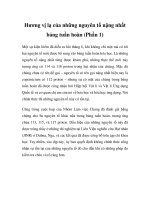Tunable lasers handbook phần 1 ppt
Bạn đang xem bản rút gọn của tài liệu. Xem và tải ngay bản đầy đủ của tài liệu tại đây (12.42 MB, 50 trang )
HANDBOOK
'TICS AND PHOTONICS
t
I
Tunable
Lasers
HANDBOOK
OPTICS
AND
PHOTONICS
(formerly
Quantum
Electronics)
SERIES
EDITORS
PAUL
E
LIAO
Bell Communications Research, Inc.
Red Bank, New Jersey
PAUL L.
KELLEY
Lincoln Laboratory
Massachusetts Institute
of
Technology
Lexington, Massachusetts
IVAN
P.
KAMINOW
AT&T
Bell Laboratories
Holmdel,
New
Jersey
A
complete
list
of
titles
in
this series appears at the end
of
this volume
Tunable
Lasers
ANDBO
Edited
by
F.
J.
Duarte
Eastman
Kodak
Company
Rochesrer,
New
York
ACADEMIC PRESS
San
Diego New
York Boston
London Sydney Tokyo Toronto
This
book
is
printed
on
acid-free paper.
@
Copyright
0
1995 by ACADEMIC
PRESS,
INC.
All Rights Reserved.
No part of this publication
may
be reproduced or transmitted in any form or by any
means, electronic or mechanical, including photocopy, recording, or any information
storage and retrieval system, without permission in writing from the publisher.
Academic Press, Inc.
A Division of Harcourt Brace
&
Company
525 B Street, Suite 1900, San Diego, California 92101-4495
United Kingdom Edition published by
Academic Press Limited
24-28 Oval Road, London NW1 7DX
Library of Congress Cataloging-in-Publication Data
Duarte,
F.
J.
(Frank
J.)
p.
Tunable lasers handbook
/
F.
J.
Duarte.
Includes index.
ISBN 0-12-222695-X
1. Tunable lasers.
I.
Title. 11. Series.
cm.
-
(Optics and photonics series)
TA1706.D83 1995
621.36'6-dc20 95-8165
CIP
PRINTED
IN
THE
UNITED STATES
OF
AMERICA
95 96 9798 99 00EB 9
8
7
6 5
4
321
Contents
Contributors
xi
Preface
xiii
1.
Introduction
1
2.
Tunable Laser Complementarity
4
3.
GoalofThisBook
5
References
6
and Intracavity Dispersion
F.
J.
Duarte
1.
Introduction
9
2.
Dispersive Oscillator Configurations
10
vi
Contents
3. Physical Dimensions 15
4. Generalized Interference Equation 16
5.
Dispersion Linewidth Equation 17
6. Beam Divergence 19
7. Intracavity Dispersion 19
8.
Intracavity Multiple-Prism Dispersion and Pulse
9. Transmission Efficiency of Multiple-Prism
Compression 23
Arrays 24
Appendix: Dispersion of Multiple-Prism Arrays
and 4
x
4
Transfer Matrices
References
3
1
10. Wavelength Tuning 26
29
D.
G.
Harris
1.
Introduction 33
2. Excimer Active Media 35
3. Tuning of Discharge and Electron Beam Pumped
4.
Discharge Excimer Lasers
53
Excimer Lasers 41
References 59
Charles Freed
1. Introduction 63
2.
Vibrational Energy-Level Structive
of
the CO,
Molecule 65
3.
Rotational Energy-Level Substructure
of
the CO,
Molecule 69
4.
Processes Governing the Excitation
of
Regular Band
Laser Transitions
in
CO,
5.
Additional Characteristics
of
Regular Band
CO,
Lasers Transitions 74
6. Lineshape Functions and Broadening Due to Gas
Pressure and Doppler Shift in CO, Gas
7.
Spectral Purity and Short-Term Stability 79
7
1
76
Con
tents
vi
8.
Long-Term Line-Center Stabilization
of
CO,
Lasers 82
9. Absolute Frequencies of Regular Band Lasing
Transitions in Nine CO, Isotopic Species 95
10. Pressure Shifts in Line-Center-Stabilized CO,
Lasers 137
1
1.
Small-Signal Gain and Saturation Intensity of
Regular Band Lasing Transitions
in
Sealed-off
CO,
Isotope Lasers 144
12. Laser Design 149
13. Spanning the Frequency Range between Line-Center
14. Spectroscopic Use of
CO,
Lasers outside Their
Stabilized CO, Laser Transitions 154
Fundamental 8.9- to 12.4-pm Wavelength Range
References 16 1
159
1. Introduction 167
2. Laser-Pumped Pulsed Dye Lasers
3.
Flashlamp-Pumped Dye Lasers 179
4.
cw Laser-Pumped Dye Lasers
5.
Femtosecond-Pulsed Dye Lasers 191
6. Solid-state Dye Lasers 195
172
184
Appendix of Laser Dyes 200
References 215
Transition Metal Solid-state Lasers
Norman
P.
Barnes
1. Introduction 219
2. Transition Metal and Lanthanide Series Lasers 225
3. Physics of Transition Metal Lasers
4. Cr:A1,0, 246
5. Cr:BeA1,04 251
6. Ti:Al,O, 258
7.
Cr:LiCaA1F6 and Cr:LiSrAlF,
263
8. Cr:GSGG, Cr:YSAG, and Cr:GSAG
270
9.
Co:MgF,, Ni:MgF,, and VMgF,
18.
Wavelength Control Methods 281
232
275
References 288
viii
Contents
Norman
P.
Barnes
1.
2.
3.
4.
5.
6.
7.
8.
9.
10.
Introduction 293
Parametric Interactions 297
Parametric Oscillation 301
Spectral Bandwidth and Acceptance Angles
Birefringence Effects 3 14
Average Power Limitations 3 17
Nonlinear Crystals 321
Phase-Matching Calculations 328
Performance 334
Tuning 343
References 345
306
Tunable External-Cavity
Semiconductor Lasers
Paul
Zorabedian
1.
2.
3.
4.
5.
6.
7.
8.
9.
10.
11.
12.
13.
14.
15.
16.
17.
18.
Introduction 349
Semiconductor Optical Gain Media 352
Classes of External-Cavity Lasers 368
First-Order Properties 370
Feedback Model 375
External-Cavity Design 377
Cavity Components 383
Survey
of
External-Cavity Laser Designs
Mode Selectivity
of
Grating Cavities
Phase-Continuous Tuning 409
Characterization Methods for External-Cavity
Lasers 412
Measurement
of
Facet and External-Cavity
Reflectances 4 12
Multimode Suppression 417
Multiple-Wavelength Operation 420
Wavelength Stabilization 42 1
Advanced Modeling Topics 422
Construction and Packaging 427
Applications 430
References 435
398
407
Contents
iX
Stephen Vincent Benson
1.
Introduction 443
2.
Methods
of
Wavelength Tuning
3. Broadly Tunable Optical Cavities
4. Wiggler Considerations 459
5.
Tunable Laser Facilities
and
Their
Characteristics 460
6. Summary 468
References 468
450
456
Index
471
Contributors
Numbers in parentheses indicate the pages
on
which the authors' contributions begin
Norman
P.
Barnes (219,293), NASA Langley Research Center, Hampton, Vir-
Stephen Vincent Benson (443), Accelerator Division, Continuous Electron
E
J.
Duarte
(1,9,
167),
Eastman Kodak Company, Rochester, New York 14650
Charles Freed
(63),
Lincoln Laboratory and the Department
of
Electrical
Engineering and Computer Science, Massachusetts Institute
of
Technology,
Lexington, Massachusetts 02173
ginia 23681
Beam Accelerator Facility, Newport News, Virginia 23606
D.
G.
Harris
(33),
Rockwell International,
Canoga
Park,
California
91309
R.
C.
Sze
(33),
Los
Alamos National Laboratory,
Los
Alamos, New Mexico
Paul Zoralbedian (349), Photonic Technology Department, Hewlett-Packard
87545
Laboratories, Palo Alto, California 94303
xi
Preface
Light and color are concepts that have always invoked thoughts
of
joy
and
won-
der. Perhaps the essence
of
light is well captured in the realm of poetry where
light has been identified as a “changing entity
of
which we can never
be
sati-
ated” (Gabriela Mistral, 1889-1957).
This book is about changing light; it is about light sources that emit the
colors of the rainbow and beyond. Indeed, the central theme
of
this book
is
changing light
of
high spectral purity
or,
as a physicist would say, tunable
coherent radiation.
Tunable lasers ar unique physical systems that enjoy an abundance
of
appli-
cations ranging from physics
to
medicine. Given this utilitarian aspect, the sense
of
wonder in tunable lasers extends beyond beauty.
Tunable Lasers
Handbook
provides a broad and integrated coverage
of
the
field, including dispersive tunable laser oscillators, tunable excimer lasers, tun-
able
CO,
lasers, dye lasers, tunable solid-state lasers, optical parametric oscilla-
tors, tunable semiconductor lasers, and free electron lasers. In this regard, the set
of
coherent sources considered here spans the electromagnetic spectrum from
the near ultraviolet to the far infrared. Further features are the inclusion
of
both
discretely and broadly tunable lasers, pulsed and continuous wave lasers, and
gain media in the gaseous, liquid, and solid state.
xiii
xiv
Preface
Although the basic mission of this work is to offer an expeditious survey
of
the physics, technology, and performance
of
tunable lasers, some authors have
ventured beyond the format of a handbook and have provided comprehensive
reviews.
This project was initiated in
1990.
Completion in late
1994
has allowed the
inclusion
of
several recent developments in the areas of solid-state dye lasers,
optical parametric oscillators. and external cavity tunable semiconductor lasers.
The editor is particularly grateful to all contributing authors for their hard work
and faith in the vision of this project.
E
J.
Duarte
Rochester;
NY
January
1995
Eastman Kodak Company
Rochester,
New
York
1.
INTRODUCTION
Tunable sources
of
coherent radiation are suitable
for
a wide range of appli-
cations in science, technology, and industry. For instance, the first broadly tun-
able laser source, the dye laser, is used for a plethora
of
applications in many
diverse fields
[
11
including physics
[24],
spectroscopy
[5,6],
isotope separation
[6-81,
photochemistry
[9],
material diagnostics
[9],
remote sensing
[9-11],
and
medicine
[12].
In addition to issues
of
physics, it
is
this utilitarian aspect
of
tun-
able lasers that motivates much
of
the interest in the field.
In recent years, new sources
of
tunable coherent radiation have become
available that have either extended spectral coverage or yielded appealing emis-
sion characteristics. Notable among these sources are optical parametric oscilla-
tors
and tunable semiconductor lasers.
This field has several natural subdivisions. For instance, although most
sources
of
tunable coherent radiation are lasers, some sources such as the optical
parametric oscillator
(OPO)
do not involve population inversion.
An
additional
classification can be established between broadly tunable sources
of
coherent
radiation, including broadly tunable lasers, and discretely tunable lasers, and/or
line-tunable lasers.
A
subsequent
form
of
classification can be the physical state
of
the difFerent gain media such as gaseous, liquid, and solid state. Further
Tunable
Lasers
Handbook
Copyright
0
1995
by
Academic Press,
Inc.
All rights of reproduction
In
any
form reserved
2
F.
J.
Duarte
avenues
of
differentiation can include the required method of excitation and the
mode of emission, that is, pulsed or continuous wave (cw). Moreover, sources of
tunable coherent radiation can be further differentiated by the spectral region of
emission and energetic and/or power characteristics. Also, in the case
of
pulsed
emission, pulse duration, and pulse repetition frequency (prf) are important.
The spectral coverage available from pulsed broadly tunable sources of
coherent radiation is listed in Table
1.
The spectral coverage available from cw
broadly tunable lasers is given in Table
2
and emission wavelengths available
TABLE
1
Wavelength Coverage Available from Pulsed Broadly Tunable Sources
of Coherent Radiation
Source Wavelength range
Dye lasers 320-1 200
nmo
[
131
Ti3+:A1,03 laser
660-986
nm
[
141
Cr3+:BeAl2O, laser 701-818 nm [I51
OPO
BBO
0.41-2.7
pm
[I61
Free-electron lasers (FELs) 2
urn-1
mmb
[I71
UWavelength range covered with
the
use of various dyes.
Kombined wavelength range from several free-electron lasers.
TABLE
2
Wavelength Coverage Available from cw Broadly Tunable Lasers
Laser source Wavelength range
Dye lasers
Ti3+:AI2O,
laser
~
320-1000
rima
[18]
710-870 nmh [19]
Semiconductor lasersc
InGaAsPDnP
InGaAsPDnP 1255-1335 nm [21]
GaAlAs 815-825 nm [22]
GaAlAs
55 nm at 1500 nm [20]
20 nm at 780 nm [23]
0
Wavelength range covered with the
use
of
various dyes.
bWavelength range of single-longitudinal-mode emission. Tuning range limited by coatings
of
c
Wavelength tuning achieved using external cavity designs.
mirrors [19]. Commercial designs offer extended tuning ranges beyond
1000
nm.
1
Introduction
3
from discretely tunable lasers are listed in Table 3 of Chapter 5. The information
provided in these tables indicates that broadly tunable sources
of
coherent radia-
tion span the electromagnetic spectrum from -300
nm
to
-1
mm.
Excimer lasers
offer limited tunability in regions further into the ultraviolet around 193 and 248
nrn.
The tuning ranges quoted for
ArF
and KrF lasers are
-17,000
GHz
and
-10,500
GHz
[24], respectively.
An
exception among excimer lasers is the XeF
laser with its C+A transition, which has demonstrated broadly tunable emission
in the 466- to 512-nm range [25]. In Table 3 of Chapter
5
bandwidth and tuning
range information is included for a variety
of
discretely tunable lasers including
excimer,
N,,
HgBr, and Cu lasers. Wavelength information on line-tunable cw
lasers such
as
Ar+
and the
Kr+
lasers is included in Table
11
of Chapter
5.
Ener-
getic and power characteristics of some tunable sources of coherent radiation are
listed in Table
3
of this chapter. Although the title of this book refers specifically
to
tunable
[users,
sources that do not involve population inversion in their gener-
ation of coherent radiation are included. This approach is justified because the
issue under consideration
is
the generation
of
tunable coherent radiation, which
is precisely what
OPOs
perform.
In
the area of ultrashort-pulse generation, dye lasers have demonstrated
17 fs using intracavity pulse compression [36] and 6 fs using further extra
TABLE
3
Coherent Radiation
Energy and Power Characteristics from Broadly Tunable Sources of
Source Pulse regime cw regime
Energy0 Power. Powera
Dye lasers
400
Jh
[26]
2.5
kW at
13.2
!dIzc
[27] 43
Wd
[28]
Ti?+:AI,O, laser
6.5
Jb,e
[29] 5.5
W
at
6.5
kHz(
[30] 43
Wdf[32]
Cr3+:BeAI2O4 laser
>lo0
Jh
[33]
6.5
Ws
[34]
OPOS
BBO
>lo0
mJ
[16]
LrnO,
10
mW
[35]
FELS
220
W
at
110
Hzb
[31]
-
GW
levels
in
short
pulses
[I71
UThese values may represent the best published performance
in
this category.
hUnder flashlamp excitation.
dUnder
AI?
laser excitation.
eUses laser dye transfer
in
the excitation.
fliquid-nitrogen cooled.
wUnder Hg-lamp excitation.
Under copper-vapor-laser
(CVL)
excitation.
4
F.
J.
Duarte
cavity compression [37]. Utilizing intracavity negative dispersion techniques,
Ti3+:Al,03 lasers have yielded 11 fs [381. Also,
62
fs have been reported in
OPOs using extracavity compression [39]. Emission from FELs is intrinsi-
cally in the short-pulse regime with pulses as short
as
250
fs [17].
2.
TUNABLE
LASER
COMPLEMENTARITY
From the data given previously it could be stated that tunable sources of
coherent radiation span the electromagnetic spectrum continuously from the near
ultraviolet to the far infrared. However, this claim of broad coverage is sustained
from a global and integrated perspective of the field. Further, a perspective of
complementarity is encouraged by nature, given that different sources of tunable
coherent radiation offer different optimized modes of operation and emission.
In this context, under ideal conditions,
the application itself should deter-
mine the use
of
a particular laser
[40,41]. This perspective should ensure the
continuation of the utilitarian function traditional of the early tunable lasers that
ensured their success and pervasiveness.
To
determine an appropriate laser for a given application, the logic of selec-
tion should identify the simplest and most efficient means to yield the required
energy, or average power, in a specified spectral region. In practice, the issue
may be complicated by considerations of cost and availability. In this regard,
selection of a particular pulsed laser should include consideration of the follow-
ing parameters:
1.
Spectral region
2.
Pulse energy
3. Average power (or prf)
4. Cost (capital and operational)
5.
Environment.
More subtle issues that are also a function of design include the following:
6.
Emission linewidth
7. Wavelength and linewidth stability
8.
Pulse length (femtoseconds, nanoseconds,
or
microseconds)
9. Physical and optical ruggedness
10.
Amplified spontaneous emission
(ASE)
level.
A basic illustration of complementarity is the use of different types of lasers
to provide tunable coherent radiation at different spectral regions. For instance.
FELs can be recommended for applications in need of far-infrared emission,
whereas dye lasers are suitable for applications requiring high average powers in
the visible.
1
Introduction
5
A more specific example of the complementarity approach can be given
in
reference
to
isotope separation. In this regard, the necessary spectroscopic infor-
mation including isotopic shifts, absorption linewidths, and hyperfine structure
can be studied using narrow-linewidth tunable cw lasers. On the other hand, for
successful large-scale laser isotope separation high-average-power pulsed tun-
able lasers are necessary
[6,27].
A further example is the detection and treatment
of surface defects in optical surfaces being used in the transmission mode for
imaging applications. The detection and assessment of the surface defects is
accomplished using interferometry that applies tunable narrow-linewidth cw
lasers. Surface treatment requires the use of pulsed lasers operating in the high
prf regime.
Recently, complementarity in tunable lasers has been taken a step further
with the integration of systems that utilize complementary technologies
to
achieve a given performance. An example is the use of a semiconductor-laser
oscillator and
a
dye-laser amplifier
[42].
Also, the event of high-performance
solid-state dye-laser oscillators
[43]
has brought the opportunity
to
integrate
these oscillators into
OPO
systems
[44].
3.
GOAL
OF
THIS
BOOK
The goal of this book is to provide an expeditious guide to tunable sources
of coherent radiation and their performance. Issues of physics and technology
are also considered when judged appropriate.
In
this book, this judgment has
been made by each individual contributor. Although the basic function
of
a
handbook is to tabulate relevant physical and performance data, many works
under that classification go beyond this basic format. In this book, several chap-
ters go beyond the classical concept of a handbook and provide a detailed dis-
cussion of the data presented.
From a practical perspective, the intended function of this book is to offer
scientists and engineers the means to gain an appreciation for the elements and
performance of tunable lasers and ultimately
to
assist the reader to determine the
merit of a particular laser relative to a given application.
3.1
Book
Organization
The
book
is divided into nine chapters including this introduction.
A
chapter
on narrow-linewidth oscillators is introduced prior to the main collection
of
chapters given the broad applicability
of
the subject matter. The main body
of
the book is basically organized into two groups of chapters categorized as dis-
cretely tunable lasers and broadly tunable lasers. Discretely tunable lasers are
considered first because that also satisfies the more technocratic division
of
the
6
F.
J.
Duarte
subject matter in terms of physical state, that is, gas, liquid, and solid-state lasers
consecutively. Here, note that because dye lasers have been demonstrated to lase
in the three states of matter, their positioning between gas and solid state is quite
appropriate. Free-electron lasers are listed at the end
of
the broadly tunable
coherent sources given their uniqueness as physical systems.
Chapter
2
treats narrow-linewidth oscillators and intracavity dispersion.
The subject matter in this chapter is applicable to both discretely and broadly
tunable lasers in the gaseous, liquid, or solid state. Chapter
3
addresses tunable
excimer lasers including ArF, KrF, XeC1, and XeF. Chapter
4
is dedicated to
tunable CO, lasers oscillating in the cw regime. These two chapters deal with
discretely tunable lasers in the gaseous phase.
Broadly tunable sources and lasers are considered in Chapters
5
to
9.
Chap-
ter
5
deals with dye lasers and Chapter
6
with transition metal solid-state lasers.
The latter chapter includes material on Ti3+:A1,03 and Cr3+:BeAl,04 lasers.
Chapter
7
considers the principles of operation and a variety of crystals used in
optical parametric oscillators. The subject of tunable semiconductor lasers is
treated in Chapter
8
with emphasis
on
external cavity and wavelength tuning
techniques. Chapter
9
provides an up-to-date survey of free-electron lasers.
For historical information and basic references
on
the various types
of
tun-
able lasers, the reader should refer to the literature cited in the chapters. The
reader should also be aware that the degree of emphasis
on
a particular laser
class follows the judgment
of
each contributing author. In this regard, for exam-
ple, high-pressure pulsed CO, lasers are only marginally considered and the
reader should refer to the cited literature for further details. A further topic that is
related to the subject of interest, but not a central objective of this volume, is fre-
quency shifting via nonlinear optics techniques such as Raman shifting.
REFERENCES
1.
E
J.
Duarte and
D.
R. Foster, in
Encyclopedia ofApplied Physics
(G.
L.
Trigg, Ed.), Vol. 8, pp.
2. V.
S.
Letokhov, in
Dye Lasers:
25
Years
(M.
Stuke, Ed.), pp. 153-168, Springer-Verlag, Berlin
3.
J.
F.
Roch, G. Roger, P. Grangier,
J.
M. Courty, and
S.
Reynaud,
Appl. Phys.
B
55,291
(1992).
4.
M.
Weitz, A. Huber,
E
Schmidt-Kaler, D. Leibfried, and T. W. Hansch,
Phys. Rev. Lett.
72,
328
(1 994).
5.
R.
J.
Hall and A. C. Eckbreth,
in
Laser Applications
(J.
F. Ready and
R.
K.
Erf, Eds.), Vol.
5,
pp.
213-309, Academic, New York (1984).
6.
J.
A. Paisner and R.
W.
Solarz, in
Laser Spectroscopy and Its Applications
(L.
J.
Radziemski,
R. W. Solarz, and
J.
A. Paisner, Eds.), pp. 175-260, Marcel Dekker, New York (1987).
7.
E
J.
Duarte, H.
R.
Aldag,
R.
W. Conrad, P. N. Everett,
J.
A. Paisner, T.
G.
Pavlopoulos, and
C.
R.
Tallman, in
Proc.
Int.
Con$
Lasers
'88
(R.
C.
Sze and
E
J.
Duarte, Eds.), pp. 773-790,
STS Press, McLean, VA (1989).
8.
M.
A. Akerman, in
Dye Laser Principles
(E
J.
Duarte and
L.
W. Hillman,
Eds.),
pp. 413418,
Academic, New York (1990).
331-352, VCH, NewYork (1994).
(1992).
1
Introduction
9.
D. Klick, in
Dye Laser Principles
(E
J. Duarte and
L.
W. Hillman, Eds.). pp.
345412,
Acade-
mic, New York
(1990).
10.
W. B. Grant,
Opt. Eng.
30,40 (1991).
11.
E.
V.
Browell,
Opt. Photon.
News
2(10), 8 (1991).
12.
L.
Goldman, in
Dye Laser Principles
(F. J. Duarte and
L.
W. Hillman, Eds.), pp.
419432,
Acad-
13.
E
J.
Duarte and
L.
W. Hillman, in
Dye Laser Principles
(F.
J.
Duarte and
L.
W.
Hillman, Eds.),
14.
P.
F. Moulton,J.
Opt. Soc.Am.
B
3,
125 (1986).
1.5.
J.
C. Walling,
0.
G.
Peterson.
H.
P.
Jenssen.
R.
C.
Morris,
and E. W. O'Dell.
IEEE
J.
Quantum
16.
A. Fix,
T.
Schroder.
R.
Wallenstein, J.
G.
Haub,
M.
J.
Johnson, and B.
J.
On,
J.
Opt.
Soc.
Am.
B
17.
S.
Benson, private communication,
1994.
18.
L.
Hollberg, in
Dye Laser Principles
(F.
J.
Duarte and
L.
W. Hillman,
Eds.),
pp.
185-238,
Acad-
19.
C.
S.
Adams and A.
I.
Ferguson,
Opr. Commun.
79,219 (1990).
20.
R.
Wyatt and W.
J.
Devlin,
Electron. Lett.
19, 110 (1983).
21.
P.
Zorabedian,
J.
Lightwave
Technol.
10, 330 (1992).
22.
M.
W.
Fleming and A. Mooradian,
IEEE
J.
Quantum Electron.
QE-17,44 (1981).
23.
K.
C. Harvey and G. J. Myatt,
Opt. Lett.
16,910 (1991).
24.
7.
R.
Loree,
K.
B.
Butterfield, and D.
L.
Barker,
Appl.
Phys.
Lett.
32, 171 (1978).
2.5.
T.
Hofmann and F. K. Titrel,
IEEE
J.
Quantum Electron.
29,970 (1993).
26.
F.
N.
Baltakov, B. A. Barikhin, and
L.
V.
Sukhanov,
JETP Lett.
19, 174 (1974).
27.
1.
L.
Bass,
R.
E. Bonanno,
R.
P.
Hackel, and
P.
R.
Hammond,
Appl. Opt.
33,6993 (1992).
28.
H. J. Baving,
H.
Muuss, and W. Skolaut,
Appl.
Phys.
B
29,
19 (1982).
29.
A. J. W. Brown and C. H. Fisher,
IEEE
J.
Quantum Electron.
29,2.513 (1993).
30.
M.
R.
H. Knowles and
C.
E.
Webb,
Opt. Lett.
18,607 (1993).
31.
A. Hoffstadt,
Opt. Lett.
19, 1523 (1994).
32.
G.
Ebert,
I.
Bass,
R.
Hackel,
S.
Jenkins, K. Kanz, and
J.
Paisner, in Conf.
Lasers and Electro-
Optics,
Vol.
11
of
OSA Technical Digest Series, pp.
390-393,
Optical Society of America,
Washington, DC
(1991).
33.
J.
C. Walling, in
Tech. Digest Int.
Conf.
Lasers
'90,
paper MH.3, Society for Optical and Quan-
tum
Electronics. San Diego, CA
(1990).
34.
J.
C. Walling,
0.
G.
Peterson, and
R.
C. Morris,
IEEE
J.
Quantum Electron.
QE-16, 120 (1980).
35.
D. C. Gerstenberger and
R.
W. Wallace,
J.
Opt. Soc. Am.
B
10, 1681 (1993).
36.
A. Finch,
6.
Chen, W. Sleat, and W. Sibbett,
J.
Mod. Opt.
35, 345 (1988).
37.
R.
L.
Fork, C. H. Brito-Cruz, P.
C.
Becker, and C. V. Shank.
Opt. Lett.
12,483 (1987).
38.
M. T. Asaki,
C.
P. Huang, D. Garvey,
J.
Zhou, H. C. Kapteyn, and
M. M.
Murnane,
Opt. Lett.
18,
39.
Q. Fu.
G.
Mak, and H.
M.
van Driel,
Opt. Lett.
17,
1006 (1992).
40.
F.
J.
Duarte,
Laser
Focus
World
27(5),
25 (1991).
41.
F.
J.
Duarte,
Lasers Optron.
10(5),
8 (1991).
42.
A.
M.
Farkas and
J.
G.
Eden,
IEEE
J.
Quantum Electron.
29,2923 (1993).
43.
E
J.
Duarte,
Appl. Opt.
33,
3857 (1994).
44.
B.
J.
Om,
private communication,
1994.
emic, New York
(1990).
pp.
1-15,
Academic, New York
(1990).
Electron.
QE-16, 1302 (1980).
10, 1744 (1993).
emic, New York
(1990).
977 (1993).

